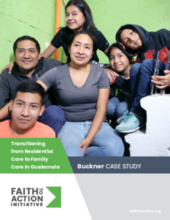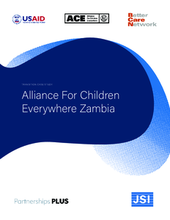Mapping the human resource landscape and making connections
Transition does not happen in a vacuum. Organizations undergoing transition typically engage with and draw support from wide range of other organizations, practitioners and/or government bodies.
The aim of this step is to begin to identify and connect with others and tap into the available human resources at a local, national, and where relevant, international level. Making these connections and expanding networks helps in envisaging solutions to challenges, forming the right partnerships, formulating the right approach and procedures for transition and helps connect transition efforts to national child protection and care reforms, where they are underway.
This step is primarily focused on networking and partnership formation. Key actions may include:
- Identifying, connecting with and strengthening relationships with the relevant government duty bearers (government bodies with child protection responsibilities) at a local and national level.
- Networking with other organizations involved in aspects of child protection and care reforms or child protection/child welfare service provision.
- Joining working groups, networks or peer learning groups.
- Identifying and connecting with other organizations who’ve undergone transition in the same country or region.
- Identifying and connecting with organizations or practitioners who offer various forms of technical support for specific aspects of transition.
- Vetting, negotiating terms and formalizing partnerships where transition will be undertaken in partnership with others.
The key milestones associated with this stage are that the organization’s key decision makers have:
- A clear understanding of the mandated role of government in transition and the reintegration of children (where formal gatekeeping is in place) and how this will influence aspects of their transition (case management, registration and licensing of services, reporting).
- Sufficient peer and technical support to enable safe transition has been sourced and the organisation feels confident to move into the planning phase.
- Partnerships with other organizations/individuals who will help guide the transition have been negotiated, roles and responsibilities clarified, and partnerships formed/formalized.
- Initial relationships formed with organizations who may provide additional support and services to the organization’s beneficiaries (children and families) throughout transition and beyond
- Confidence to move into the planning phase
Resources
Displaying 1 - 5 of 5
Resistance from donors is a common barrier for organizations transitioning from residential care to family-based care. What works to sustain and even increase funding for organizations in transition?
The story of Heartline’s transition from residential care to family care is told in this recently released Faith to Action case study. The case study details their experience through three stages of transition—learning, preparation and planning, and full transition—with transparency. It addresses common challenges for transitioning organizations, as well as the strategies Heartline took to overcome them.
The story of Buckner Guatemala’s transition from residential care to family care is told in this recently released Faith to Action case study. The case study details their experience through three stages of transition—learning, preparation and planning, and full transition—with transparency. It addresses common challenges for transitioning organizations, as well as the strategies Buckner took to overcome them.
This learning brief was developed as part of the CTWWC 2022 annual report and shares learning from across different contexts. It is intended to showcase how the transition of care services is happening and how it can be supported.
Alliance for Children Everywhere (ACE) Zambia is a US-funded organization that transitioned from providing residential care in Zambia to pioneering family-based care, including foster care, and supporting other residential care service providers to transition. With important links to the Zambian government, ACE Zambia has been a key actor in supporting the development of policies, programs and guidelines that are now utilized across the country.




